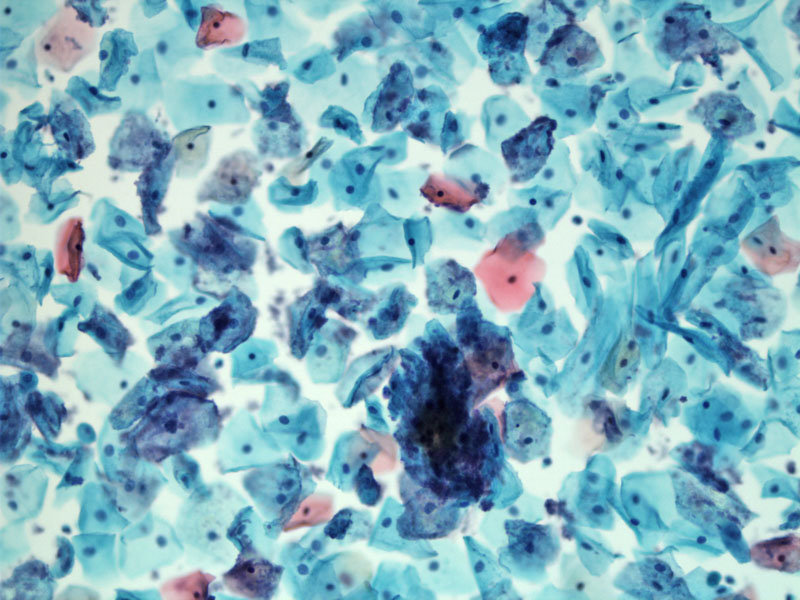

The Pap smear reveals a clump of squames and single squamous cells coated in bacteria. Both Pap smears and wet mounts can demonstrate clue cells.
A clue cell with a purple filmy coat studded with bacteria can be appreciated (arrow).
Bacterial vaginitis (BV) is caused by an imbalance of normal vaginal flora, shifting from a lactobacilli-dominant environment to one containing a mixed flora. The organisms commonly found in BV include Gardnerella vaginalis, Mobiluncus species, Mycoplasma hominis and Peptostreptococcus species.
Diagnostic criteria for BV includes: (1) Vaginal pH >4.5: Normal vaginal pH lies between 3.8 to 4.5, which usually inhibits growth of pathogens. Increased alkalinity is more permissive to bacterial overgrowth; (2) grey to white frothy malodorous vaginal discharge; (3) wet mount or Pap smear demonstrating >20% clue cells; (4) a fishy smell released when mixed with potassium hydroxide.1,2
BV is the most common cause of symptomatic vaginitis comprising up to 50% of cases. Other common causes of vaginitis include Candidiasis and Trichomoniasis. Risk factors for BV include situations that alter vaginal pH and decrease the amount of hydrogen-producing (therefore protective) lactobacilli. Douching, contraceptives, antibiotics, IUD devices, STDs, smoking and changes in sexual intercourse patterns have all been associated with BV. Note that BV is not an STD.
BV is a common infection among pregnant women and black women. Up to 16% of pregnant women in the US are affected by BV and a CDC survey reports the incidence of BV among African American women to be 23%, compared to 16% in Hispanics, 9% in Caucasians and 6% in Asians (Gor). Among pregnant women, the presence of BV does indicate an increased risk of a preterm delivery, though treatment does not appear to modify this risk.
Treatment typically targets anaerobic organisms. Oral courses of metronidazole or clindamycin are employed. More recently vaginal topical preparations of these medications have become available. Alternatively, efforts at recolonization with lactobacillus using natural preparations such as yogurt are also available.
Infection is associated with an increased risk of upper genital tract infection (ie. endometritis, PID), wound infection (ie. after hysterectomy), chorioamnionitis and spontaneous abortion. While treatments are effective, there is a high recurrence risk.
1 Nucci MR, Oliva Esther. Gynecologic Pathology: Foundations in Diagnostic Pathology. Philadelphia, PA: Elsevier: 2009: 78-9.
2 Gor HB. Vaginitis: eMedicine. Last updated 12/8/08. Accessible at: emedicine.medscape.com/article/257141-overview
